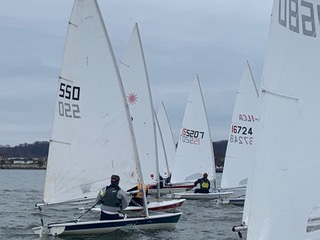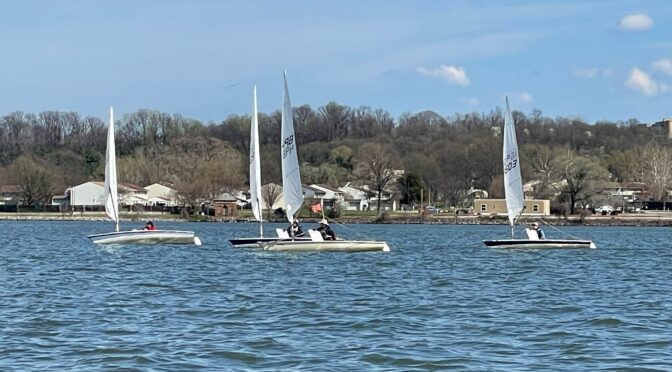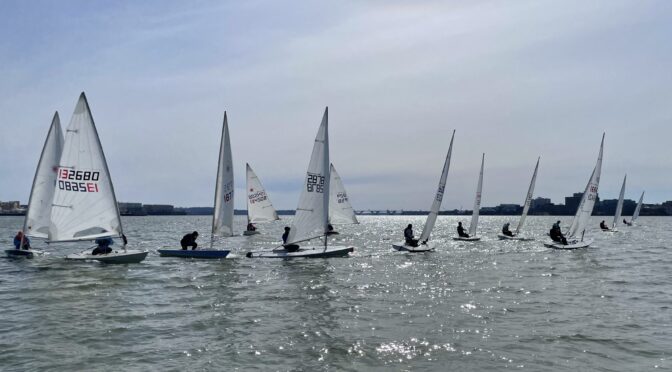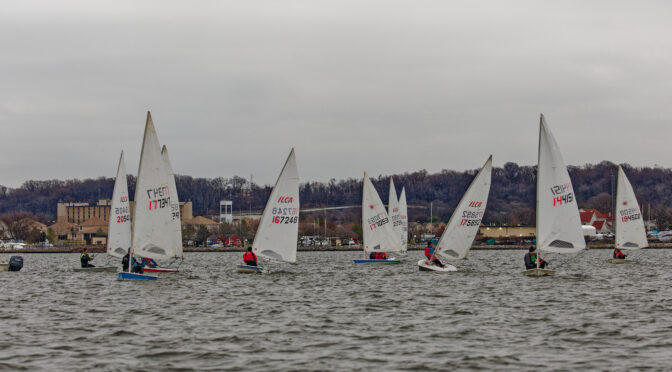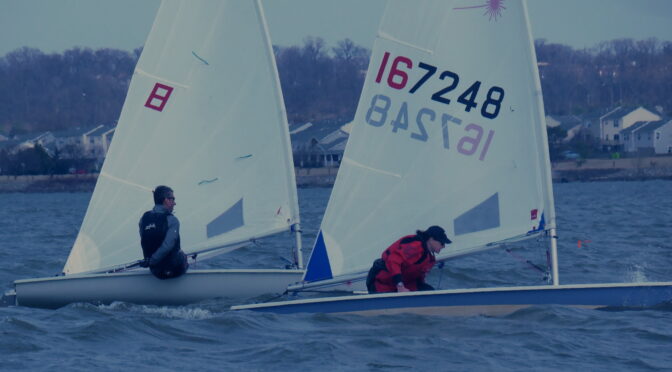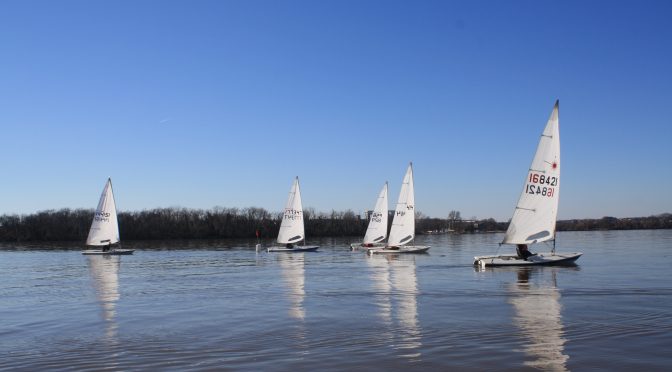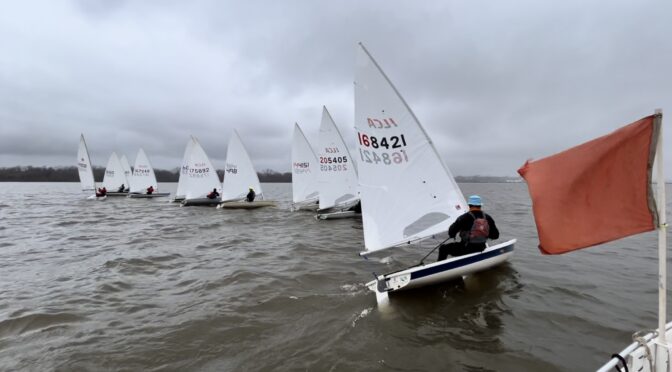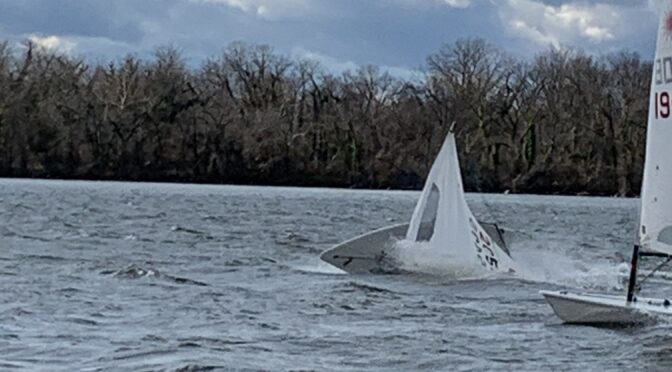Well today was a tough day. We had a mostly westerly that seemed to have oscillating directions of about +/-45 degrees at times and velocity chances from 2 to 10. Generally speaking the breeze was out of the west at about 5 knots I would guess though. The shifty conditions made racing tough with lots of position changes throughout the race and no one really owning the day.
All posts by Farley Will
2024-2025 ILCA Frostbite #1
On a puff and a shift: First 3rd place write-up of the season
To those who are new to frostbiting, it is our tradition that whoever gets 3rd place circulates a short write-up about the day, and I volunteered to do this first one. It was great to see 18 boats on a day when the forecast wasn’t exactly promising. Also great to see both familiar and new faces. The first gamble of the day was whether to race at all, and we gave it a go. After bobbing around with no wind from changing directions, we ended up with a slowly building southernly light breeze and had three good light-air races. Good on Farley and Tyler for calling when the wind direction stabilized, resetting the course, and getting us going. A few lessons from the sailing today:
Starting well and not early with light breeze and the current pushing us to windward is tricky. My plan was to stay a bit behind the line and make sure I have space to build up speed before the start. I didn’t execute any of the starts particularly well including being the sole boat across the line in race three – thanks to Farley or Tyler who called out a crisp “405”.
Being fast upwind required staying alert while the boat imitated the motions of a crib lulling you to sleep. I had the vang slightly looser than 2-blocked, a deep curve from the outhaul, and absolutely nowhere near using the cunningham. Finding clear air, doing your best to roll tack, not having to duck others unless really necessary helps. But the big gains were on calling the puffs and the shift. In my read, the puffs were particularly important, and they’re easier to spot than the shifts. It’s always a gamble whether you get it right, but you can improve the odds by looking at the water down river and at the boats ahead of you.
Downwind legs felt long with the current against us, but they seemed more predictable to me than the upwind legs. Speed came from keeping the wind flowing across the sail either by the lee or on a broad reach, i.e. avoiding going dead downwind, and keeping that slight windward heel that avoids weather helm. Also, with 18 boats, being on the left side is tactically helpful when you approach the mark.
Racing on the Potomac in light air has a crapshoot element, so take the knocks in your stride – sometimes it really works out. At the last leeward mark of the last race, I was well behind Jim and Laura. A strong puff and a nice shift helped me catch up so much that Jim had to yield to me on starboard just before the finish line, and I barely crossed the line ahead of him. I surely didn’t deserve that one, but it will help me feel better next time the puffs and shifts don’t go my way.
Altogether a nice and easy kick off to the frostbite season, and thanks to Farley and Tyler for running the races today.
Steen
PS: don’t forget to sign up for RC duty!
2023 ILCA Frostbite Series #18
Greetings from 3rd place — belatedly, thanks for your patience! — on the last day of the frostbite season (can hardly believe it). Many thanks to Tom and Jim for taking one for our collective team and doing race committee and helping us get in 6 races – glad it was a nice afternoon for you guys! Kudos also to Steen and Farley for taking the top two spots.
But back to Sunday, briefly. It was forecasted to be a dying wind after gale/near-gale conditions and sometimes it was quite light – but the wind generally held up. The current was going out all afternoon and sometimes it felt like it was the main propellant downwind. The wind was fluky – sometimes the left was better, sometimes the right. Mostly, I tried to look for puffs and keep the boat going fast regardless of where my wind indicator was pointing. I also tried to keep tabs on who was where and how they seemed to be doing (but could have done this more, it would likely have helped!).
Finally – don’t forget to sign up for the Capital City Regatta next weekend!!! —> https://nextsailor.com/app/
Laura
2023 ILCA Frostbite Series #17
I think this is the second time I have raced a Laser since Y2K. Here are some thoughts.
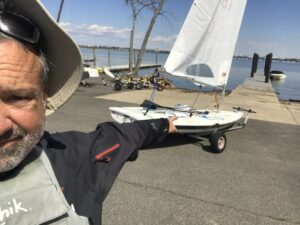
CURRENT: High tide was at 1518, however recent rains to the west must have filled the river as we had an out going current all day. I am not intimately familiar with this part of the Potomac. Reviewing my RaceQs record (see attached file), the extent of the course for races 2-5 was roughly mid way between the east and west shores. The bathymetry would have gradually increasing depth from right to left looking upwind. I would expect the current to be slower on the west side of the course due to it being shallower water and in the “lee” of the mud flats surrounding the airport landing lights.
WIND: While rigging I had forgotten to install the battens in the sail. Everyone had departed, so I slid the boat from its dolly onto the grass and rolled it over. In the process I saw the dirt and grime covering the hull – figuring that no one would be racing in such light air – and gave it a quick cleaning. By the time I got to the course area I saw the fleet in the final throes of race #1 that was started in an easterly that morphed into a nearly non-existent southerly for the final two legs. The breeze gradually, sporadically filled in from the south for races 2-5. This was nothing like our regular, thermal-driven southerly. More often than not, we saw gusts from the east. The combination of favorable current and SE gusts drew me to the left more often than not. Now, the day’s forecast was for a southerly breeze shifting to west and increasing at around 1400. I was half expecting people to come from the far right, planing into the mark – but this never occurred. The westerly finally showed up, nearly two hours late and right after the final race. Bottom line is that if one were going to pick a side, in the absence of any other indications, the left (east) appeared to be favored. What will it be next time? No freaking clue.
RANDOM OBSERVATIONS: I kept overstanding the windward mark. I don’t recall the Laser being that close winded. Maybe it was me mis judging the current. We had a few fleeting moments where we had to hike and almost enough wind to blow the leech open. I put tell tales in the middle of the sail. None on the leech – its always stalled anyway. My new dry suit worked really well: the relief zipper served its purpose – a heretofore untested and critical piece of technology!
IN SUM: The PRSA frostbite program continues to function well. I recall my first sail on the Potomac during the winter of 1982-83 in penguins and then lasers. Just about all the names have changed but the sailing is still tricky, challenging, and fun. The informal post race social was fun and enhanced by the bright sunshine and 74 deg F temperatures. GF Lee drove down and brought some snacks. Celeste brought Elmarie. Special thanks to Tyler and Eva for serving as RC.
Barney
23-24 PRSA ILCA Frostbite Series #17
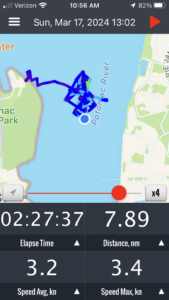
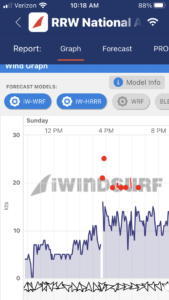
2023-2023 ILCA FROSTBITE #14
Sunday was one of the best days of racing I have had this season. While light winds had been forecasted, the wind quickly increased to around ten knots with gusts well above that. It came from the south-southeast but would periodically shift farther southeast and less commonly would shift farther south. The puffs almost always came from the left side of the course. This combined with the prevailing shifts meant that the far left seemed the place to be for most of the day. While the pin was not significantly up for many of the starts, I felt that starting at the pin and taking off left was the way to go. The tide was outgoing the whole day, and so there was very significant up-course current. It took me seven seconds to travel upwind one boat length upwind at the first start while luffing.
The first start, we were in a left shift and most of the fleet was set up for the pin. I was OCS and decided to gybe and head upwind on port. I was lifted for a long time but eventually found a more average angle to tack on and head left. I rounded the weather mark in the back, but caught up to the fleet. The downwinds all day were very interesting. Because the pressure came from the left, a balance had to be struck between staying in the puffs and working to get the inside around the leeward mark. Personally, I found that by staying on the left side I could usually cleanly pass people I might have gotten tangled up with around the mark. I passed a few boats downwind, rounded the mark, and tacked immediately. I was headed for a while, but I got clear air and a very nice shift on the left side that put me in the upper half of the fleet around the top mark. The next downwind was fairly standard, I don’t remember passing anyone. The finishing leg was played very differently to the rest of the racing and overall I thought it was something I could have done better all day. It seemed like it was preferable to stay on port until on layline for the boat and then tack. I ended up finishing around fifth.
The second race went very similar. This time I accounted for the current more and was not over, but did not have a very good start. I decided to stay on starboard longer than anyone else to get clear air, and as a result overstood the layline. All day, I was right on the edge of being able to keep the boat flat in the puffs ( I am very light for the full rig). Being overstood definitely hurt more than normal because it was harder to keep the boat flat in low mode. I rounded the top mark in fifth but had a bad rounding and lost a boat right after. The downwind was very standard and I caught the boat that had passed me. All day, I thought staying more to the course left than your opponents was the only sure way to prevent them getting an excellent shift and making a comeback both upwind and downwind. By the end of the leg, I was overlapped with many boats and attempted to go wide and fall in behind the pinwheel. This did not quite go as intended and I ended up on the outside of a group. I tacked underneath and managed to gain a boat or two back on the upwind just by staying left. By now, the fleet was spread out and again I finished fifth.
The third race, I got an amazing start by winning the pin. Pretty quickly, I got headed but decided to just keep going because of good pressure up ahead. This turned out to be pretty costly and I dropped back to around third. I stayed there for the downwind but closed some distance. Rounding the top mark, I tacked on the first right shift and headed left. Shortly after, the wind began to die all over the course. It stayed a little longer on the right and it looked like some people made good gains over there. However, I could see whitecaps just before the bridge on the left and so headed that way, trusting that the wind would fill in. I have found that in general if the wind is dying and then coming back, betting on the new system rather than the old is favorable. I caught the shift perfectly as the pressure came back and ended up rounding the weather mark in first. I held this to the end of the race and took the win.
Race four, I had another great start at the pin. I found that setting up low was crucial because of the current and that there was enough wind a long runup was not essential. This was another advantage to going left upwind. Deeper water means more current so heading near the channel allowed for better speed upwind. I tacked in a much better place than race three and rounded the weather mark in first. I held on for the downwind, but going back up the wind had increased and I was struggling to keep the boat flat. I was passed by sail 603 as a result. I got close to catching him on the downwind but was unable to and followed him for the rest of the race.
Race five was very similar, I rounded the top mark in second by banging the left corner on the upwind. I was unable to catch the boat in first but managed to hold on until the last leg. Going upwind on port tack, the whole fleet was very lifted. I found a decent shift back and decided to tack sooner, mostly to cover the boats behind me. This turned out to be a mistake as I lost one boat and finished in third. I noticed someone behind me getting to the inside of a pinwheel by going very by the lee in a puff and planing for a few seconds, this seemed to work very well.
Race six, I had a good start but lost my lane quickly and was sucked back into the pack. I stayed left longer than any of the boats near me to get clear air, but two boats went further and both beat me to the weather mark along with a few others. I caught two boats downwind, but lost one back upwind because I went too far left and overstood. On the second downwind, I was sailing by the lee trying to get to a covering position when I was hit with a surprise puff and spun out into a capsize. I got to the board quickly but the sail was on the windward side so when I brought the boat up it flipped over again. I probably should have california rolled, but I had touched the bottom while righting the boat and was unsure if it was deep enough (as well as if my drysuit neck seal was good). I finished last in that race.
All told, it was a fun day on the water with near-ideal conditions that made the racing very interesting and enjoyable. If you could find a good angle on starboard tack, there were almost always opportunities to gain. While the downwind was fairly straightforward with no gybe until the end necessary, this led to great opportunities by playing for the inside and covering your opponents.
Credit to Kaitlyn for getting a good photo!
2023-2023 ILCA FROSTBITE #13
Big thank you to the Race Committee for running 5 great races. The weather was near ideal with the air temp in the 40s and wind between 12 and 19 kts for most of the day. I did consider briefly rigging up my radial sail as I worried that the realized conditions would beat the forecast. However, I gambled that the forecast would be accurate and wouldn’t exceed my cut off point (20 kts+) for wanting an easier rig to manage. Despite not being overpowered, I did manage to capsize upwind during the 3rd and 4th races. After chatting with Farley and Laura onshore, I think it was because I was overcompensating for some recent bad habits (oversteering while tacking and coming out low) and understeering and then crossing the boat too slowly. Laura did have a general comment that outhauls were too tight and people needed to keep some shape in their sails and not over flatten them.
My focus of the day was on having good starts and avoiding people. The line was set for the 15ish boats that signed-in so there was plenty of room to work with only 10 boats starting. With the wind out of the South and a flooding tide weakening the current, I was not worried about being over early. My strategy was to start in the middle and capitalize on the expected midline sag. Each race, I’d find a safety transit (a line from the back of the motor through the pin to something on shore) and aim to start accelerating from a couple boat lengths back at 10 seconds. The strategy worked 4 out of 5 starts with having clear air and on the line at the gun, only time it didn’t work is when I lost sight of Tom and he rolled me. After the start I worked my way up to the windward mark trying to minimize the number of tacks coming in close to the port ley line. Downwind, I worked to the inside to not give up the inside overlap. I was often able to pick up boats at the final leeward mark by rounding well and then sailing to the starboard ley line and finishing at the boat.
Tyler
2023-2023 ILCA Frostbite #12
Here is your post game third place writeup from sailing today!
Today was definitely one of those days where you needed to show up to see what was happening on the river. While the forecast was for really light and rain all day, it turned out to be a really nice day. The wind stayed all day between 5 and 8 knots out of slightly east of north. Thanks to Chris and Logan for running 6 races for us! And it really only rained for 2 races which also had the best wind.
As for the racing, there were no over early boats due to a strong out flowing current. This meant that there was also considerable line sag that needed to be watched out for. It also meant that you needed to be smart about your tacks. I felt like each time I tacked I slid back a little on the course. This was most evident if you missed the ley line at the windward mark and had to do a quick double tack.
I felt like starts were the most important part of the day. Chris and Logan did a really good job adjusting the start line each race. As mentioned, I think there was likely considerable sag in the line each start which mean some people would start “on the line” and be a boat length behind at the beginning. With a well set line, the pin should be slightly favored and it was each race, but the wind shifts and the length of the line made me think the boat might be a good starting spot. I was wrong every time I did this and ended up playing catchup attempting to catch Steen and Laura. My better races were definitely the ones where I started at the pin. I think this was due to the line sag and wind direction at or shortly after each start that allowed the pin starting boats to tack and cross the fleet.
Other important thoughts all day were:
- Keep clear air going down wind. This was relatively easy since you were automatically by the lee when rounding the windward mark on starboard and it was difficult for people to get on top of you if you just stayed a little bit inside of boat behind you.
- Do not pinch upwind.
- Watch for the shifts.
And unlike two other similar days this season with heavy current and light wind, the wind was a little more than those and you did not need to foot as much to make headway up river against the current. You could sail a little more “normal”.
It is also very interesting that we had a 4 way tie for places 5-8! There was a lot of really close sailing today!
Hope to see everyone out next week!
Farley
2023-2024 ILCA FROSTBITE #11
I figured I would send out my Third place write-up once my body had recovered from this Sunday. It’s not quite there, but here we go… Somehow being contorted into all manner of light air sailing positions is about as painful as heavy air.
Sunday was warm and sunny, roughly 50 F, and I’d say we had a blustery 2-4 knots.
There were several naysayers, but my boat was rigged and I was wearing a drysuit so I launched my laser and pushed off the dock. Reaching the racecourse was slow going, but after riding a few airplane exhausts I had arrived. I generally did not notice heavy current as I didnt seem to be drifting against the shoreline, but upwind felt more painful than downwind. (Although, the downwind legs were generally more broad reaches).
Throughout the day, the wind was light and seemed to vary between north, east, and southeast directions. My start of Race 1 felt pretty good, and I was off the line with some of the leaders. Unfortunately, I was tracking to port (west) of the windward mark and as the wind filled in from the east, I had to duck most of the fleet on port as it slowly sailed by in a line like ducks in a row. After rounding the windward mark, the wind continued to be from the east. A cluster of boats sailed high fighting for the windward spot, and I was able to consolidate downwind by sailing more directly to the mark and finished in 5th place after the 1 lap course.
For Race 2, I fought for a boat start to be closer to the wind (still coming from NE to SE). I came off the line with ok speed on starboard and ahead of many boats that were below the line at the start. I noticed some boats (specifically Laura, I think) with tight outhauls and cunninghams to minimize draft and allow the low velocity wind to flow across the sail. I tried tightening my cunningham but ultimately left it largely off after being traumatized by the vertical crease running down the sail. (I’d like to hear what other folks tried for such light air). Laura was ahead of me and slightly to windward, and seemed to be pointing higher than me. Whenever I began sailing to leeward of her, I would tack onto port to avoid her windshadow and move closer to the wind coming from the eastern shore. I believe I rounded ahead, but pretty far behind Steen. With no boats around me, I continued to sail the downwind leg, the second lap, and finished in 2nd place.
For Race 3, I felt that the pin was more to windward, but perhaps it was just a more even start line than prior starts. I attempted to start near the pin, but found myself buried behind boats, shadowed, and with little speed. After the gun, I tacked onto port and passed behind nearly the entire fleet until I reached the RC boat, where I tacked back onto starboard to finally cross the start line. The wind dropped to its lightest in Race 3. As soon as I could clear the RC boat’s anchor line I tacked onto port to again try and chase any light puffs coming from the east. Farley, Steen, Laura, and Logan had a good lead on the fleet and they seemed to be moving forward. I seemed to manage either slight forward momentum or holding position, while the rest of the fleet appeared to be drifting backwards. The upper half of the windward leg John had good speed and achieved overlap and rounded ahead of me. Downwind I was able to pull ahead into 5th place. I dont really recall the second upwind, but I largely held my position. For the second downwind Logan was holding the high lane by going left (east shore), but I consolidated by heading straight to the leeward mark. Logan seemed to have to fight back towards the leeward mark for the rounding. For the final upwind leg and the finish I was able to keep my bow ahead and eventually finished in 4th place.
2023-2024 ILCA FROSTBITE #10
Good evening, Frost biters!
As Kaitlyn had promised us, we got a nice day on the river with light to medium wind from a (by Potomac standards) stable northerly direction. The results are attached thanks to Farley – both for today and the totals. Below are a few highlights.
Eva gave the tip of the week of the year: When you’ve capsized enough times, find your way back to shore. Last time we sailed, for me that number was one.
With the strong current and medium wind, be aggressive on the start line. If you find yourself too close to the line, all you need to do is head to wind for a moment, you’re back where you need to be, and there’s enough wind to get going again. Today’s conditions really provided a safe environment for practicing getting a front row spot.
As my mother has told me for fifty years, dress appropriately. I thought with the mild temperature today, I’d skip a layer, and I ended up being a bit cold. A warm torso keeps your fingers warm, and more importantly, I think I had poor focus today partly because I was cold.
The current in the Potomac remains an enigma to me. Today’s current was strong, so it mattered. Current runs strong where the water is deep, so logic would suggest staying on the left side (west) upwind and on the left side (east) on the downwind. I think this tended to be true, but certainly not always. If someone has cracked the code of the Potomac currents, please let us know.
As you can see from the totals, we’ve had just 26 races, with hopefully more than that ahead of us, so everyone has a good chance for a good spot by the end of the season. Hope to see many of you next week.
Steen
2023-2024 ILCA FROSTBITE #7
Sunday was a nice day. The air was warmer than it had been the previous week, and the sun was shining. Everything was perfect, except for the wind. While on shore at the start of the day, the wind felt sporty but manageable. I was running a radial sail. The airport reported 13 knots from the south at noon. When sailing out, it was clear that conditions had changed drastically since then. Significant breeze to plane was found in the lagoon, however the area of the course was experiencing a very weak wind from the south. This was very quickly replaced by a very strong wind from the northwest. At 1, the airport recorded 15 knots gusting to 27. The course was set and racing began.
The first race I was OCS, and decided to tack to port and duck the line. I stayed on port for a long while and found a large right shift. This was noticeable throughout the day, the wind was oscillating between weaker wind from the west and strong puffs from the northwest. I made most of my ground back up on the right side and rounded the weather mark mid-fleet. The downwind was a lot of fun in full planing conditions, and most of the boats that I saw doing well stuck close to the rhumb line. Almost no boats gybed more than once. I maintained position for this downwind and had a fairly good mark rounding that put me in pretty clean air. I made a mistake in staying too far to the right on the second upwind and lost a boat or two. I saw one or two boats capsized near the windward mark. The final downwind leg was very similar to the first, except near the end I hit a puff wrong and auto gybed. I managed to stay upright and finished the race somewhere in mid fleet.
By the time of the second race, the wind had increased greatly. At 2, the airport recorded eighteen knots gusting 28. I put on all the controls as tight as I could except for the vang, which was in block to block position. I was late to the start, so tacked out early again. By this time, I was not really trying to be in the optimal spot on the course. My tacks and gybes are not very good, especially not in wind like that, so I did my best to play it safe and minimize the risk of capsizing by minimizing the number of tacks and gybes. I did not tack again until the layline, and ended up overstood due to another right shift. Still, I rounded in the top half of the fleet. The downwind was a survival leg. I saw at least two boats flip and when I pulled up my centerboard a little I immediately began to oscillate. I left the vang on for stability and because I wasn’t sure I could get it back for the upwind. While the wind was challenging, the waves were relatively small and there was sufficient power to go over them without much worry. This was when things started to get crazy. Almost half the fleet capsized at some point. I autogybed downwind and spun out, but managed to dry capsize and get moving relatively quickly. By the time I got to the second upwind mark rounding, most of the fleet was sailing in. I dropped one place on the final downwind but managed to stay upright.
By race 3, only six boats were left on the course. The wind had now increased to 30 knot gusts and sustained winds over 20. I was on time to the line, but hit some waves wrong and lost my lane. Again, I tacked out early and tacked back at the layline. I set a rule for myself, two tacks or one gybe were allowed per leg. Even if I didn’t capsize, my tacks often ended with the boat heeled over like crazy and side slipping. I rounded the weather mark in fourth. Race committee had set a triangle course, so the downwind was a lot of fun and very simple. I tried to stay a little low on the first reach to get the puffs that would come from the right. On the second reach, I would sail to the mark or maybe a little high for the pressure. On these reaches, the boat began to hum and I had to fight the tiller to keep going in a straight line. I left all controls on because I didn’t think I could adjust them safely while being ready for the puffs. On the finish leg, I caught a boat that had capsized right before the finish.
Race 4 started similarly. I was late due to a bad tack and again hit the right corner. While definitely not optimal, this strategy was pretty close and got me to the windward mark with no complications. I rounded in fourth with lots of space between me and third. On the first reach, all three boats in front of me flipped. They got up before I reached them, but I closed almost all of the distance. A massive puff was chasing me the entire first reach, and I barely gybed before it hit. I had to hold the tiller with both hands on that reach to keep from spinning up and out. When I got to the lee mark, I had passed a boat. I let the boat round up, but lost control and flipped. I dry capsized, but had been overtaken and got fourth in the race.
Overall, it was a hectic but incredibly exciting day. I capsized more times than I can count on the way in and on the course. Race committee did an excellent job balancing rescuing boats and maintaining the course. I don’t think that I was sailing at peak in terms of boatspeed from hiking or strategy, but getting around the course with as little capsizes as possible was far more important. I don’t think there was a single boat that didn’t flip at some point. I was very surprised by my third place, but I think that I was consistent throughout the day and did well as a result. My starts were often not quite where I wanted them to be, but the general conditions and small fleet size reduced the importance of the start significantly.
Logan

